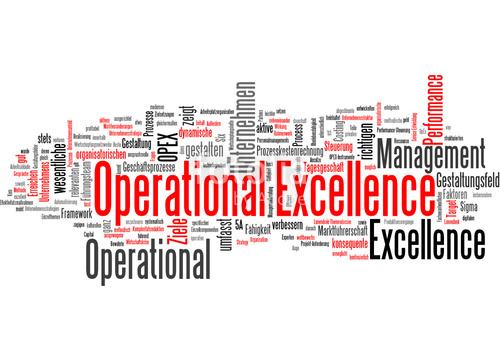The Business Environment in today's day & age is far different from that a couple of decades ago - thanks to factors like Globalization, blazing-fast Technological upgradations, Government reforms, and many others. As Mr. Benjamin Disraeli, a famous British politician, had rightly pointed out "Change is Inevitable; Change is Constant". No organization can stay at a fixed position for long. It either has to move forward (i.e, Grow in business) or be beaten by its competitors (i.e, perish). Over 6.8 lakh Indian companies have closed down since our Independence in 1947, which is equivalent to almost 36% of the total number of Indian companies registered under the Registrar of Companies. The only option available for any organization to survive in the competition is to Grow. Operational Excellence (OPEX) is a one-stop solution, which can ensure the growth and profit of the company.
Achieving true Operational Excellence is easier said than done. However, true OPEX can be achieved if a company can adhere to what I call the "5S' Approach". Let's see what these 5S' stand for.
1. Sketch

The first S is to clearly Sketch out:
- The Goals & Target of the organization. What needs to be kept in mind is that Goals should always be SMARTER, i.e,
- Specific - Nothing can be achieved if we pursue everything. Be specific!
- Measurable - That, what is not measured, cannot be optimized!
- Achievable - Don't try to push a wall. Go for building a door instead!
- Relevant - Stay relevant (to the Business Vision and Mission) or be outcasted!
- Time-Bound - Time is Money. So, chop-chop!
- Evaluate - Without proper evaluation, failure is inevitable!
- Readjust - A small correction (at every stage) is better than getting discarded in the end!
- 5W1H of achieving the Goals. Goals, by definition, have no practical impact if they are not accompanied by a Plan of Action. Thus, we need to lay down the following clearly:
- What are the Goals? (SMARTER Goals)
- Why do the Goals need to be achieved? (the Business Impact)
- Who will be involved in achieving the Goals? (the Resources required)
- When will the Goals be accomplished? (the Time Frame)
- Where do the Goals need to be achieved? (the Physical factor of an Organization)
- How will the Goals be achieved? (the Process)
2. Start:

The second S is to Start with the implementation of the Action Plan. The best way to get something done is to begin! The factors impacting Implementation are what is commonly known as the 5M's - Man, Machine, Material, Method and Money. People are arguably the most important asset a company can have. As the famous saying goes "You don't build a business; you build people, and then people build the business". All the 5Ms are interdependent and have a combined impact on the business. However, the variability in every stage is what makes this Stage so complex. This brings in the need for the third S - Simplify.
3. Simplify:

With all the variabilities at every step of every process, implementation of the points of Action would take an eternity to complete. The complexities also lie in the sheer volume of interdependent processes that go on in every organization on a daily basis. This is why we need the help of the OPEX tools like Lean, Six Sigma, TPM, TQM, and the like in order to facilitate seamless implementation (within the stipulated time). All these tools aim at considering and focusing only on the value-added activities and eliminating the rest. However, this is again easier said than done. The main challenge lies in identifying and quantifying these value-added activities out of the thousands of existing activity pools. Once a simplified (lean) process has been instilled, the need for the next S comes into existence - Sustain.
4. Sustain:

Let us understand this with an example of a person trying to push a boulder up the hill. The person cannot stop exerting efforts for even one microsecond until the goal is reached. Even the smallest of slacks at any point can result in a complete roll-down to the starting point and thus, a complete wastage of efforts. Similarly, in the real-life, once a Kaizen (small improvement) has been implemented, the major focus has to be shifted towards getting a sustained benefit from the Kaizen. The Will to Sustain is the differentiating factor between a "Successful" organization and the others. I feel that Sustaining is the most difficult stage of all the five since it requires sustained and disciplined efforts of each and every employee to make a company "Successful". In the words of the great Mr. Abraham Lincon, "Discipline is choosing between what you want now, and what you want most". It is tough to become disciplined in action at an individualistic level, let alone at a collective level. Mr. Jim Rohn, a famous American entrepreneur, had correctly said, "Discipline is the bridge between Goals and Accomplishments".
The last, but not the least S to achieving OPEX is Scrutinize.
5. Scrutinize:

This is where most of the companies falter (at a collective level). Let us understand why, through a simple example. We often keep on completing each step (in a process) without proper inspection of our work and finally find out (at the end of the process) that we have done a major blunder in one of the steps. The options left for us at that time are either to rework the whole process from the step where we faltered or to scrap the whole thing and start afresh. In this case, the collective impact of small deviations is large. On the contrary, the impact would have been of lesser impact, if we would have reviewed our work after every step and corrected the deviations subsequently. The same is in the case of industries. One point to note here is that Inspection needs significant amount of capital investment. Thus, setting up an Inspection booth after every process would result in an increase in abnormal overheads. Thus, industries need to set-up an optimum number of inspection booths at significant process steps. This is the challenge that companies are facing in today's working scenario.
This "5S' Approach", if implemented truly, is sure to drive companies towards true "Excellence".


Very well thought and insightful model. As proposed by you, companies need to decide their goals and targets in a SMARTER way and technological advances in collection and analysis of data will play a crucial role in setting well 'Measured' goals and targets.
ReplyDeleteexcellent
ReplyDeleteVery lucid interpretation and importance of 5S to leave a vivid imprint in mind of readers.
ReplyDelete